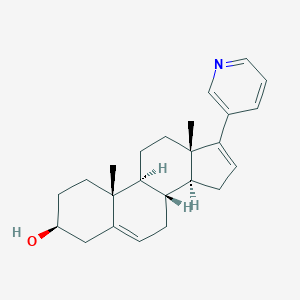Search for drugs:
Typing the drug name to query
ABIRATERONE ACETATE
DIR Classification
Classification:Less-DIR concern
Severity Score:1
Description in Drug Labeling: View Full Labeling: SPL in DailyMed | PDF
- WARNINGS AND PRECAUTIONS
- Hypokalemia, Fluid Retention, and Cardiovascular Adverse Reactions due to Mineralocorticoid Excess
- Closely monitor patients whose underlying medical conditions might be compromised by increases in blood pressure, hypokalemia or fluid retention, such as those with heart failure, recent myocardial infarction, cardiovascular disease, or ventricular arrhythmia. In postmarketing experience, QT prolongation and Torsades de Pointes have been observed in patients who develop hypokalemia while taking abiraterone acetate.
- ADVERSE REACTIONS
- Post Marketing Experience
- Cardiac Disorders: QT prolongation and Torsades de Pointes (observed in patients who developed hypokalemia or had underlying cardiovascular conditions).
- CLINICAL PHARMACOLOGY
- Pharmacodynamics
- Cardiac Electrophysiology
- In a multi-center, open-label, single-arm trial, 33 patients with metastatic CRPC received a dose of 1,000 mg once daily orally of another abiraterone acetate product at least 1 hour before or 2 hours after a meal in combination with a different corticosteroid orally twice daily. Assessments up to Cycle 2 Day 2 showed no large changes in the QTc interval (i.e., >20 ms) from baseline. However, small increases in the QTc interval (i.e., <10 ms) due to abiraterone acetate cannot be excluded due to study design limitations.
- PATIENT COUNSELING INFORMATION
- Advise the patient to read the FDA-approved patient labeling (Patient Information)
- Hypokalemia, Fluid Retention, and Cardiovascular Adverse Reactions
- Inform patients that YONSA is associated with hypertension, hypokalemia, and peripheral edema that may lead to QT prolongation and Torsades de Pointes in patients who develop hypokalemia while taking YONSA. Advise patients that their blood pressure, serum potassium and signs and symptoms of fluid retention will be monitored clinically at least monthly. Advise patients to adhere to corticosteroids and to report symptoms of hypertension, hypokalemia, or edema to their healthcare provider [see Warnings and Precautions (5.1)].
Postmarketing Surveillance
Contingency Table:
Current Drug
Other Drugs
Rhabdomyolysis
42
42870
Other ADRs
9054
14108225
Odds Ratio = 1.527
Drug Property Information
ATC Code(s):
- L02BX03 - abiraterone acetate
- L02BX - Other hormone antagonists and related agents
- L02B - HORMONE ANTAGONISTS AND RELATED AGENTS
- L02 - ENDOCRINE THERAPY
- L - ANTINEOPLASTIC AND IMMUNOMODULATING AGENTS
Active Ingredient:abiraterone acetate
Active Ingredient UNII:EM5OCB9YJ6
Drugbank ID:DB05812
PubChem Compound:132971
CAS Number:154229-19-3
Dosage Form(s):tablet; tablet, film coated
Route(s) Of Administrator:oral
Daily Dose:
- 1000.0 mg/day L02BX03
Chemical Structure: 

SMILE Code:
C[C@]12CC[C@@H](CC1=CC[C@@H]3[C@@H]2CC[C@]4([C@H]3CC=C4C5=CN=CC=C5)C)O
C[C@]12CC[C@@H](CC1=CC[C@@H]3[C@@H]2CC[C@]4([C@H]3CC=C4C5=CN=CC=C5)C)O
Reference
COHORT STUDY:
N/AOTHER REFERENCE(S):
N/ADisclaimer:
The content of this database of rhabdomyolysis is intended for educational and scientific research purposes only. It is not intended as a substitute for professional medical advice, diagnosis or treatment.
The views presented in this website do not necessarily reflect current or future opinion or policy of the US Food and Drug Administration. Any mention of commercial products is for clarification and not intended as endorsement.